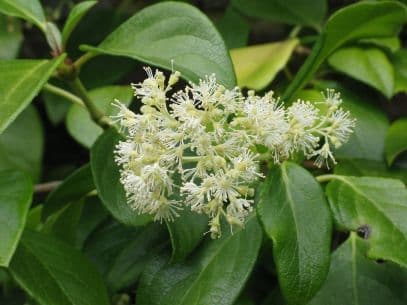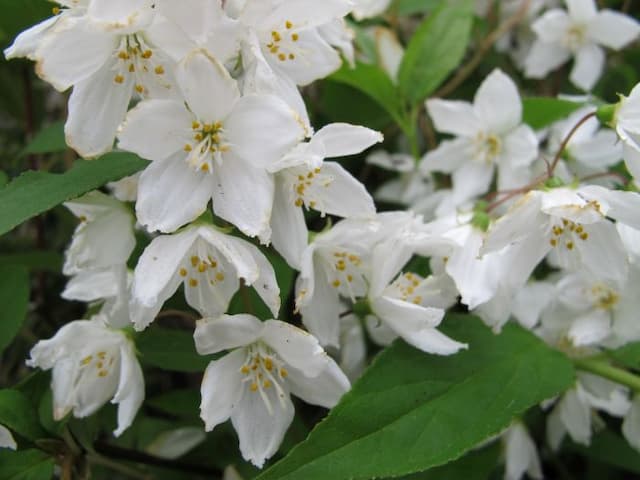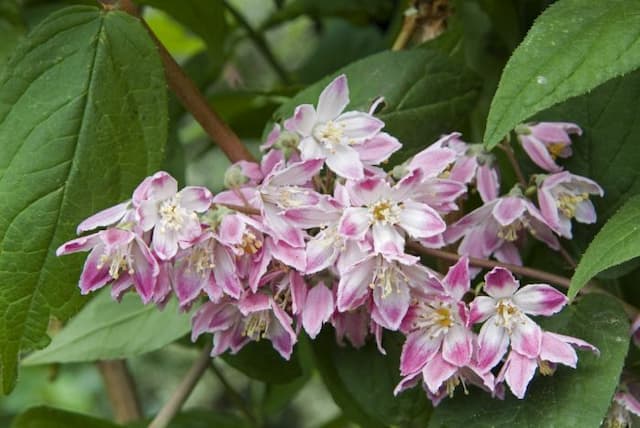Mexican Mock Orange Philadelphus mexicanus

ABOUT
Philadelphus mexicanus, commonly known as the Mexican mock orange, is an ornamental plant notable for its lush green foliage and fragrant, showy flowers. The plant's leaves are oval to lance-shaped with a pointed tip and have toothed edges, displaying a vibrant green color. The foliage provides a dense backdrop for the prominent blooms that emerge in the flowering season. The blossoms of the Mexican mock orange are its most striking feature; they are typically white and have a cupped shape, consisting of four petals. These flowers are known for their delightful aroma, which can be reminiscent of orange blossoms, and they have a tendency to attract both butterflies and bees to the garden. The flowers are usually arranged in clusters, which adds to the visual impact of the flowering display. Mexican mock orange grows as a shrub and is often utilized in landscaping for its decorative properties, with the added benefit of bringing a pleasant scent to the area it occupies. The branches of the plant can be somewhat arching, creating a graceful profile. The plant's overall appearance makes it a favored choice for gardeners looking to add a romantic and aromatic touch to their outdoor spaces.
About this plant
 Names
NamesFamily
Hydrangeaceae.
Synonyms
Mexican Mock Orange, Mock Orange.
Common names
Philadelphus mexicanus.
 Toxicity
ToxicityTo humans
The Mock Orange (Philadelphus mexicanus) is not known to be toxic to humans. If ingested, it is not expected to cause poisoning or serious harm. However, it is generally not advisable to consume parts of ornamental plants due to potential gastrointestinal discomfort.
To pets
The Mock Orange (Philadelphus mexicanus) does not have a known toxicity to pets either. It is not considered poisonous, and ingestion should not lead to significant symptoms of poisoning. Despite its non-toxic status, it's still recommended to prevent pets from eating plants as a precautionary measure for their overall health and to avoid possible mild stomach upset.
 Characteristics
CharacteristicsLife cycle
Perennials
Foliage type
Deciduous
Color of leaves
Green
Flower color
White
Height
6 feet (1.83 meters)
Spread
6 feet (1.83 meters)
Plant type
Shrub
Hardiness zones
8
Native area
Mexico
Benefits
 General Benefits
General Benefits- Aesthetic Appeal: The Mexican Mock Orange (Philadelphus mexicanus) has attractive white, fragrant flowers that enhance the beauty of garden landscapes.
- Attracts Pollinators: The scented blossoms attract bees, butterflies, and other beneficial pollinators, which is crucial for plant biodiversity.
- Ease of Care: It is a low-maintenance plant that is generally easy to care for, requiring minimal attention once established.
- Drought Tolerant: Once established, the Mexican Mock Orange can tolerate periods of drought, making it suitable for xeriscaping and water-conservation gardens.
- Privacy Screen: With its dense foliage, it can be used to create a natural privacy screen or hedge when planted in rows.
- Fast Growth: The Mexican Mock Orange has a quick growth rate, which can be advantageous when looking to quickly fill spaces in the landscape.
- Wildlife Habitat: It provides shelter and habitat for various species of birds and small mammals.
- Versatility: Suitable for a range of landscape uses including foundation plantings, borders, and as a specimen plant.
 Medical Properties
Medical PropertiesThis plant is not used for medical purposes.
 Air-purifying Qualities
Air-purifying QualitiesThis plant is not specifically known for air purifying qualities.
 Other Uses
Other Uses- Mock Orange branches can be used in floral arrangements for their sturdy structure and lush green foliage, providing a natural backdrop to more colorful blooms.
- The wood of the Mock Orange is occasionally used in cabinetry for small objects, as it can be finely grained and aesthetically pleasing.
- Due to its dense growth, Mock Orange can be used as a privacy screen or a windbreak when planted in a row or hedge formation.
- The fragrant flowers of Mock Orange can be used in perfumery, capturing the essence of their scent in fragrances or scented products.
- In garden design, Mock Orange is often used as a feature plant in sensory gardens due to its strong and delightful fragrance.
- The extensive root system of Mock Orange makes it useful for soil stabilization in erosion-prone areas.
- Mock Orange shrubs can serve as a natural habitat for wildlife, offering nesting sites and shelter for birds and beneficial insects.
- The plants are sometimes incorporated into butterfly gardens as the flowers attract various species of butterflies and other pollinators.
- Mock Orange is used in bonsai culture, where its small leaves and natural shape can be trained into miniature trees.
- Dried Mock Orange flowers can be used in potpourri blends to add a sweet, citrusy fragrance to rooms.
Interesting Facts
 Feng Shui
Feng ShuiThe Mock Orange is not used in Feng Shui practice.
 Zodiac Sign Compitability
Zodiac Sign CompitabilityThe Mock Orange is not used in astrology practice.
 Plant Symbolism
Plant Symbolism- Innocence: Often white flowers, such as those of the Mock Orange, are associated with purity and innocence due to their pristine appearance.
- Peace: The calming fragrance and delicate blossoms of the Mock Orange can symbolize tranquility and peace.
- Eternal Love: Because Mock Orange is a perennial, coming back year after year, it can represent enduring affection and eternal love.
- Brotherly Love: "Philadelphus" is derived from Greek words meaning "loving one’s brother or sister," which can be interpreted in the plant's symbolism as well.
 Water
WaterThe Mock Orange should be watered deeply, ensuring that the soil is moistened thoroughly. Particularly during dry spells or in hotter climates, water about once a week, providing approximately 1 to 1.5 gallons per plant to saturate the root zone. During cooler weather or when rainfall is ample, reduce the frequency to every two weeks or less, ensuring the soil doesn’t become waterlogged. It's crucial to adjust your watering schedule based on the weather and soil drainage to avoid overwatering.
 Light
LightMock Orange thrives in full sun to partial shade. The ideal spot for planting Mock Orange is an area where it receives at least four to six hours of direct sunlight daily. However, it also appreciates some afternoon shade in hotter climates to protect it from intense, scorching heat.
 Temperature
TemperatureMock Orange prefers a moderate climate and can handle temperatures as low as 10°F without severe damage. However, they flourish in temperatures ranging from 60°F to 85°F. Ideally, maintain a temperature above freezing during the winter months to prevent cold injury.
 Pruning
PruningTo maintain shape and encourage vigorous growth, prune Mock Orange immediately after flowering, cutting back up to one-third of the oldest stems to ground level. Pruning is typically done once yearly, and the best time is late spring or early summer, just after the plant finishes blooming.
 Cleaning
CleaningAs needed
 Soil
SoilMexican Mock Orange thrives best in well-draining soil enriched with organic matter. A soil mix with peat, compost, and perlite or sand is ideal, ensuring good drainage and fertility. The soil pH should be slightly acidic to neutral, ranging between 6.0 and 7.5 for optimal growth and blooming.
 Repotting
RepottingMexican Mock Orange doesn't need frequent repotting; doing it every two to three years is sufficient. As a moderately growing shrub, it's best to repot it if you notice signs of root crowding or when the plant has outgrown its current container.
 Humidity & Misting
Humidity & MistingMexican Mock Orange prefers moderate humidity levels. It is adaptable and does not require any special humidity considerations, making it versatile for various garden settings or as an indoor plant without the need for additional humidity control.
 Suitable locations
Suitable locationsIndoor
Provide bright, indirect light and keep soil consistently moist.
Outdoor
Plant in sun or partial shade and mulch to retain soil moisture.
Hardiness zone
8-10 USDA
 Life cycle
Life cyclePhiladelphus mexicanus, commonly known as Mexican Mock Orange, starts its life as a seed that germinates in suitable conditions of soil and temperature. Upon sprouting, it develops into a seedling and forms a root system while sprouting its first leaves. The plant enters a vegetative growth phase, where it establishes a robust framework of branches and foliage. As it matures, it begins the flowering stage, producing fragrant white flowers that attract pollinators and subsequently develop into fruits containing seeds. After pollination and seed set, the fruits release the seeds, completing the cycle. Throughout its life, the Mexican Mock Orange undergoes periods of dormancy during colder months, after which it regrows leaves and resumes growth in the spring.
 Propogation
PropogationPropogation time
Spring-summer
Philadelphus mexicanus, commonly known as Mexican mock orange, is most often propagated through stem cuttings. This popular method involves taking semi-ripe cuttings from the plant during the summer months. Typically, one selects healthy, non-flowering stems, cutting them into lengths of about 4 to 6 inches (10-15 cm). The lower leaves are removed, and the cut end is dipped into a rooting hormone powder to encourage root development. The prepared cuttings are then inserted into a moist propagating mix, ensuring at least one node is below the surface. They should be placed in a warm, sheltered location with indirect sunlight and kept evenly moist. Roots usually develop within a few weeks, after which the cuttings can be gradually acclimatized to outdoor conditions before final planting.






![Rose deutzia [Yuki Cherry Blossom]](/_next/image?url=https%3A%2F%2Fplants-admin.emdemapps.com%2Fimages%2Fplants%2F%2Fimages%2F604b6510a383a.png&w=640&q=75)
![Hydrangea [Hot Chocolate]](/_next/image?url=https%3A%2F%2Fplants-admin.emdemapps.com%2Fimages%2Fplants%2F%2Fimages%2F604b5a066e3bd.png&w=640&q=75)
![Hydrangea [Blackberry Pie]](/_next/image?url=https%3A%2F%2Fplants-admin.emdemapps.com%2Fimages%2Fplants%2F%2Fimages%2F604b56e2abc1d.png&w=640&q=75)
